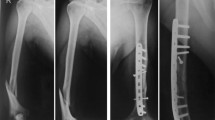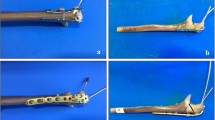Abstract
Background
Establishing fracture union of low and comminuted intercondylar fractures of the humerus is inherently challenging. The purposes of the present study were to investigate the biomechanical effectiveness of pin & plate (PP) fixation compared to other dual-plating techniques by finite element analysis, and to present a technical description as well as retrospectively review the outcomes of PP fixation in such difficult fractures.
Methods
Low-level intercondylar fracture 3D models of the humerus were virtually stabilized with three fixations on lateral side including PP, lateral pre-contoured locking compression plate (L-LCP), and variable angle lateral pre-contoured locking plate (VA-L-LCP) whereas medial pre-contoured locking compression plate (M-LCP) on medial side. Loading conditions under consideration were axial compression, internal rotation, posterior bending, and valgus rotation. Regarding the clinical series, eight patients with intra-articular and comminuted fractures of the distal humerus (6 intercondylar fractures, 1 fracture-subluxation, and 1 isolated lateral condylar fracture) were operated by isolated PP fixation or combinations of PP and the other standard implants. Data were collected on fracture union, perioperative complications, and objective clinical outcomes.
Results
Biomechanical results revealed the most instability of the fracture occurring under posterior bending. PP fixation presented comparable fracture stability and fragment displacement compared to other dual-plating fixations, except stress on the Kirschner wire under internal rotation which was higher than other fixations. Regarding the clinical series, fracture union was achieved in all cases with an average union time of 17 weeks (range 12–20). All except one patient had good-to-excellent MEPS results with an average Disabilities of the Arm, Shoulder, and Hand (DASH) score of 14.6 (range 0–45) and an average arc of elbow motion of 107.5 degrees (range 60–140).
Conclusion
By the biomechanical performance, PP fixation is a reliable technique for fixation of low intercondylar fractures of the humerus. Supported by the clinical outcomes, the present technique could be an alternative for this particular fracture especially when severe comminution prevents the use of the standard dual plating technique.












Similar content being viewed by others
Availability of data and materials
The authors confirm that the data supporting the findings of this study are available within the article and its supplementary materials.
References
Huang TL, Chiu FY, Chuang TY, Chen TH (2005) The results of open reduction and internal fixation in elderly patients with severe fractures of the distal humerus: a critical analysis of the results. J Trauma 58(1):62–69
Pantalone A, Vanni D, Guelfi M, Belluati A, Salini V (2017) Double plating for bicolumnar distal humerus fractures in the elderly. Injury 48(Suppl 3):S20–S23
Popovic D, King GJ (2012) Fragility fractures of the distal humerus: what is the optimal treatment? J Bone Joint Surg Br 94(1):16–22
Shannon SF, Wagner ER, Houdek MT, Mascarenhas D, Pensy RA, Eglseder WA (2018) Osteosynthesis of AO/OTA 13–C3 distal humeral fractures in patients older than 70 years. J Shoulder Elbow Surg 27(2):291–297
Korner J, Lill H, Müller LP, Hessmann M, Kopf K, Goldhahn J, Gonschorek O, Josten C, Rommens PM (2005) Distal humerus fractures in elderly patients: results after open reduction and internal fixation. Osteoporos Int 16(Suppl 2):S73–S79
Jeong BO, Lee DK (2012) Treatment for type C fractures of the distal humerus with the LCP distal humerus system. Eur J Orthop Surg Traumatol 22(7):565–569
Lauder A, Richard MJ (2020) Management of distal humerus fractures. Eur J Orthop Surg Traumatol 30(5):745–762
Xie X, Qin H, Shen L, Zeng B, An Z (2014) Open reduction and bi-columnar internal fixation of intra-articular distal humerus fractures through a combined medial and lateral approach. Eur J Orthop Surg Traumatol 24(7):1115–1122
Tarallo L, Mugnai R, Rocchi M, Rovesta C, Catani F (2016) Double-locking precontoured plating system for malunited fractures of the distal end of humerus. Musculoskelet Surg 100(s1):105–110
Munde SL, Bhatti MJ, Siwach RC, Gulia A, Kundu ZS, Bansal S, Middha S, Kamra HT (2015) Double tension band osteosynthesis in inter-condylar humeral fractures. J Clin Diagn Res. 9(12):8–11
Houben PF, Bongers KJ, Wildenberg FA (1994) Double tension band osteosynthesis in supra- and transcondylar humeral fractures. Injury. 25(5):305–309
Allende C, Gutierrez N, Fernandez Savoy I, Allende BT (2012) Double tension band osteosynthesis in transverse supracondylar distal humerus fractures and nonunions. Int Orthop 36(12):2565–2569
Pizzoli A, Bondi M, Schirru L, Bortolazzi R (2021) The use of articulated external fixation for complex elbow trauma treatment. Musculoskelet Surg 105(1):75–87
Frankle MA, Herscovici D Jr, DiPasquale TG, Vasey MB, Sanders RW (2003) A comparison of open reduction and internal fixation and primary total elbow arthroplasty in the treatment of intraarticular distal humerus fractures in women older than age 65. J Orthop Trauma 17(7):473–480
McKee MD, Veillette CJ, Hall JA, Schemitsch EH, Wild LM, McCormack R, Perey B, Goetz T, Zomar M, Moon K, Mandel S, Petit S, Guy P, Leung I (2009) A multicenter, prospective, randomized, controlled trial of open reduction–internal fixation versus total elbow arthroplasty for displaced intra-articular distal humeral fractures in elderly patients. J Shoulder Elbow Surg 18(1):3–12
Ray PS, Kakarlapudi K, Rajsekhar C, Bhamra MS (2000) Total elbow arthroplasty as primary treatment for distal humeral fractures in elderly patients. Injury 31(9):687–692
Baksi DP, Pal AK, Baksi D (2011) Prosthetic replacement of elbow for intercondylar fractures (recent or ununited) of humerus in the elderly. Int Orthop 35(8):1171–1177
Kamrani RS, Mehrpour SR, Aghamirsalim MR, Sorbi R, Zargar Bashi R, Kaya A (2012) Pin and plate fixation in complex distal humerus fractures: surgical technique and results. Int Orthop 36(4):839–844
Fedorov A, Beichel R, Kalpathy-Cramer J, Finet J, Fillion-Robin JC, Pujol S et al (2012) 3D Slicer as an image computing platform for the Quantitative Imaging Network. Magn Reson Imag 30(9):1323–1341
Zhao LM, Tian DM, Wei Y, Zhang JH, Di ZL, He ZY et al (2018) Biomechanical analysis of a novel intercalary prosthesis for humeral diaphyseal segmental defect reconstruction. Orthop Surg 10(1):23–31
Chantarapanich N, Sitthiseripratip K, Mahaisavariya B, Siribodhi P (2016) Biomechanical performance of retrograde nail for supracondylar fractures stabilization. Med Biol Eng Comput 54(6):939–952
Wei L, Ling M, An Z (2019) Biomechanical analysis of a novel plating for intra-articular distal humerus fractures: combined anteromedial and anterolateral plating. J Orthop Surg Res 14(1):1–7
Sabalic S, Kodvanj J, Pavic A (2013) Comparative study of three models of extra-articular distal humerus fracture osteosynthesis using the finite element method on an osteoporotic computational model. Injury. 44(3):56–61
Arnander MW, Reeves A, MacLeod IA, Pinto TM, Khaleel A (2008) A biomechanical comparison of plate configuration in distal humerus fractures. J Orthop Trauma 22(5):332–336
Stoffel K, Cunneen S, Morgan R, Nicholls R, Stachowiak G (2008) Comparative stability of perpendicular versus parallel double-locking plating systems in osteoporotic comminuted distal humerus fractures. J Orthop Res 26(6):778–784
Varady PA, von Rüden C, Greinwald M, Hungerer S, Pätzold R, Augat P (2017) Biomechanical comparison of anatomical plating systems for comminuted distal humeral fractures. Int Orthop 41(9):1709–1714
Shih CA, Su WR, Lin WC, Tai TW (2019) Parallel versus orthogonal plate osteosynthesis of adult distal humerus fractures: a meta-analysis of biomechanical studies. Int Orthop 43(2):449–460
Lee SK, Kim KJ, Park KH, Choy WS (2014) A comparison between orthogonal and parallel plating methods for distal humerus fractures: a prospective randomized trial. Eur J Orthop Surg Traumatol 24(7):1123–1131
Frigg R (2001) Locking compression plate (LCP) an osteosynthesis plate based on the dynamic compression plate and the point contact fixator (PC-Fix). Injury. 32(Suppl 2):63–66
Wilkinson JM, Stanley D (2001) Posterior surgical approaches to the elbow: a comparative anatomic study. J Shoulder Elb Surg 10(4):380–382
Ring D, Gulotta L, Chin K, Jupiter JB (2004) Olecranon osteotomy for exposure of fractures and nonunions of the distal humerus. J Orthop Trauma 18(7):446–449
Patiño JM, Rullan Corna AF, Abdon IM, Michelini AE, Mora Pulido DA (2021) Paratricipital approach for distal humerus fractures. Musculoskelet Surg 105(2):155–160
Rotini R, Ricciarelli M, Guerra E, Marinelli A, Celli A (2020) Elbow hemiarthroplasty in distal humeral fractures: Indication, surgical technique and results. Injury. 1383(20):30946–30943
Sabalić S, Maricić H, Tomicević Z, Kodvanj J (2016) Influence of gap shape on biomechanical properties of extra-articular distal humeral fracture - a finite element study. Acta Clin Croat 55(3):381–388
Durusoy S, Öner K, Özer A, Sevinç HF (2021) The effect of the angle between fracture line and Kirschner wires on stability in supracondylar humerus fractures treated with Kirschner wire fixation: a finite element analysis. J Dis Relat Surg. 32(1):75–84
Acknowledgements
The authors thank Prof. Banchong Mahaisavariya, Faculty of Medicine, Siriraj Hospital, Mahidol University and Prof. Theerachai Apivatthakakul, Faculty of Medicine, Chiangmai University, Thailand for manuscript edition and preparation.
Funding
There was no source of funding for this research.
Author information
Authors and Affiliations
Contributions
SJ and NC were involved in drafting and revising the manuscript for content, including the medical writing for the content, the study concept and design, the analysis and interpretation of the data, as well as the acquisition of the data. AG, CM, and CP were involved in revising the manuscript for content as well as the analysis and interpretation of the data.
Corresponding author
Ethics declarations
Conflict of interest
S. Jitprapaikulsarn, N. Chantarapanich, A. Gromprasit, C. Mahaisavariya, and C Patamamongkonchai declare that they have no conflict of interest.
Ethical approval
This study has been approved by the ethical committees of Buddhachinaraj Hospital in accordance with the Declaration of Helsinki.
Consent to participate
Informed consent was obtained from all individual participants included in the study.
Consent to publish
The authors affirm that human research participants provided informed consent for publication of the images in all figures.
Additional information
Publisher's Note
Springer Nature remains neutral with regard to jurisdictional claims in published maps and institutional affiliations.
Rights and permissions
About this article
Cite this article
Jitprapaikulsarn, S., Chantarapanich, N., Gromprasit, A. et al. Modified pin and plate fixation for low intercondylar fractures of the humerus: biomechanical study corroborated with a case series. Musculoskelet Surg 107, 207–221 (2023). https://doi.org/10.1007/s12306-022-00743-0
Received:
Accepted:
Published:
Issue Date:
DOI: https://doi.org/10.1007/s12306-022-00743-0




